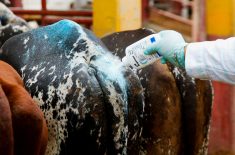A searing heatwave is baking central and northern Australia, piling more misery on drought-hit cattle farmers who have been slaughtering livestock as Australia sweltered through the hottest year on record in 2013.
Temperatures have topped 40 C in large parts of Australia’s key agricultural regions for most of the past week, with the mercury topping 48 C in the central west Queensland town of Birdsville.
The heatwave is moving east across Australia, prompting health warnings on Friday in some of the country’s biggest cities and firefighters were already battling bushfires.
Read Also

U.S. grains: Soy futures post biggest monthly gain in nearly five years on China trade optimism
U.S. soybean futures climbed to a 15-month high and posted their biggest monthly gain in nearly five years on Friday following a rally fueled by the prospect of revived exports to China.
But it is in the outback that soaring temperatures have had the most devastating impact, especially on cattle farmers in Queensland, which accounts for about 50 per cent on the national herd.
“Water supplies are fast diminishing and whatever feed supplies that were left are cooking off to the point where there won’t be any left,” said Charles Burke, a beef farmer and chief executive of Agforce, a Queensland cattle industry group.
Monsoon rains in Australia’s north failed last summer and the entire continent endured its hottest year since records began in 1910, the Bureau of Meteorology said on Friday.
Average temperatures were 1.2 C above the long-term average of 21.8 C, breaking the previous record set in 2005.
“The new record-high calendar-year temperature averaged across Australia is remarkable because it occurred not in an El Nino year, but a normal year,” David Karoly, a climate scientist from the School of Earth Sciences, University of Melbourne, said in an emailed statement.
The El Nino weather pattern is a warming of ocean surface temperatures in the eastern and central Pacific and usually brings hot, dry, and often drought conditions to Australia.
Fried eggs
In the remote town of Marree, 700 km north of Adelaide, one resident tested the folklore that you can fry an egg on the road during an outback heatwave.
“You hear stories of people frying an egg on a shovel, so we set up a shovel this morning out the front and sure enough we’ve got an egg there that’s slowly frying away,” publican Phil Turner told the Australian Broadcasting Corporation.
“So yep, we fried an egg on a shovel.”
Faced with such conditions, farmers are being forced to slaughter more cattle in the current 2013-14 season.
Australia’s cattle herd will fall to 25 million head during the 2013-14 season, the lowest since the 2009-10 season, due to increased slaughtering, the Australian Bureau of Agriculture and Resource Economics and Sciences said.
The country is the world’s third-largest beef exporter, with sales during the 2013-14 season tipped to reach A$5.4 billion (about C$5.16 billion).
Should Australian farmers continue to send cattle to slaughter due to the heatwave, future exports could fall as farmers eventually rebuild stocks when conditions improve.
The soaring temperatures have also renewed focus on climate change policy in Australia under the new government.
While Australian Prime Minister Tony Abbott has said he accepts the reality of climate change, he abolished the country’s Climate Change Commission in September, and rejected any link that global warming was responsible for a series of bushfires across New South Wales state in October.
One of Abbott’s major policies is to overturn the previous government’s carbon tax, which was aimed at reducing greenhouse gas emissions in an effort to tackle climate change.
“On the science perspective, which is the basis for taking action, you’re getting very very mixed messages from this government,” Will Steffen, an adjunct professor at The Australian National University, said in an interview.
— Matt Siegel and Colin Packham are Reuters correspondents covering politics and commodities respectively from Sydney, Australia.











